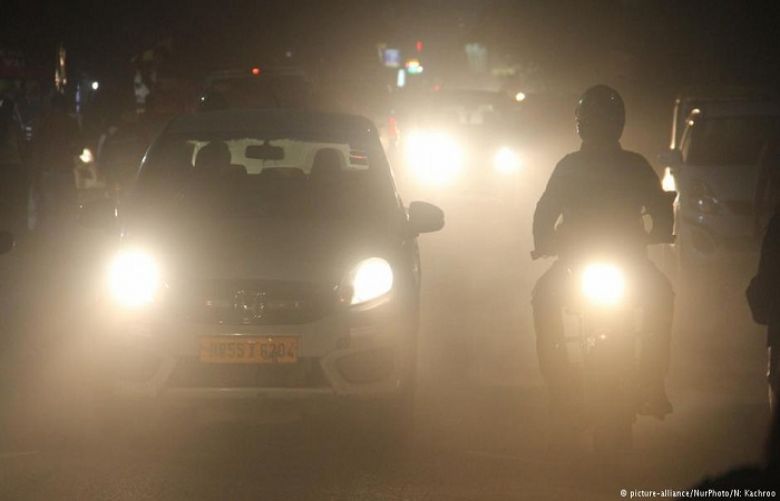Climate experts are concerned we may soon start to see more extreme weather events in the Northern Hemisphere. The culprit? A warmer Arctic, which could potentially disrupt the polar jet stream.
Whether it's long-lasting sunshine or rain that drags on for days on end, the Northern Hemisphere is experiencing extended stretches of certain kinds of weather — especially in summer.
This brings with it more extreme weather events, from heat waves and droughts that cause crop failures to torrential downpours that can flood major cities.
Climatologists say one reason for the increase of such protracted extreme weather events is due to lingering fast-moving air currents — more specifically the polar jet stream, which has shifted from its usual patterns as a result of rising temperatures in the Arctic and air pollution.
How does a warmer Arctic disrupt the jet stream?
Connecting the dots between higher temperatures around the North Pole and more extreme weather across parts of Europe, North America and Asia seems a little complicated — but it's basically all about the atmosphere. Most of our planet's weather phenomena actually get their start at 8 to 17 kilometers kilometers (4.9 to 10.5 miles) above the ground.
"Huge flows of air are orbiting our Earth in the upper troposphere — we refer to them as planetary waves," explained Joachim Schellnhuber from the Potsdam Institute for Climate Impact Research (PIK).
"The evidence is now mounting that mankind is essentially confusing these wind currents," he continued. Fueled by man-made greenhouse gas emissions, such natural circulation patterns are likely to get distorted by global warming, he said.
The waves of air that carry chains of high- and low-pressure areas oscillate from west to east, between the equator and the North Pole.
A 'curvier' polar jet stream makes weather stick around longer — resulting in bigger storms, longer droughts and stronger heat waves
But they can get held in place and slow down, which causes the weather to get stuck in a particular region. This "turns rainfall into flooding, sunny days into heat waves and dry conditions into forest fires," said Schellnhuber.
Read more: Climate change and extreme weather: Science is proving the link
Climate researchers are blaming changing temperatures in the region between the Arctic and the equator for the disturbance of these wind currents, also known as jet streams.
As a result of global warming, the Arctic is heating up faster than the rest of the Northern Hemisphere. This, in turn, reduces the temperature difference between the North Pole and the equator, which is the driving force behind the jet streams.
"There are now many studies that point to more frequent, or increased blockage of middle-latent airflows," said Simon Wang from Utah State University.
There is evidence that the winds associated with summer weather systems are weakening, and that interacts with such waves. "These combined effects suggest that weather conditions in the Northern Hemisphere last longer — and as a result, become extreme weather events."
Air pollution also slows airflow
According to estimates by climate researchers, disrupted jet streams contributed to the devastating forest fires in Canada in 2016, flooding across Europe in 2013 and Russia's deadly 2010 heat wave.
"Such events are occurring more often than would be expected due to the direct effects of global warming, so there must be an additional effect of climate change happening here," explained climate scientist Michael Mann from Pennsylvania State University.
With the help of computer simulations, he and a colleague discovered yet another factor that could cause the planet's jet streams to slow down and fluctuate even more — air pollution made up of particulate matter and sulfur particles, along with soot that is suspended in liquid droplets or air in so-called anthropogenic aerosols.
The findings of this research have now been published in the journal Science Advances.
This happens because air pollution blocks some solar radiation. In regions that have many coal-fired power plants, for example, this leads to slightly cooler regional temperatures — at least temporarily.
The same effect also reduces the temperature difference between mid-latitudes and the Arctic, making it another driving force behind the disruption of atmospheric air flows.
So could this change be permanent? Stefan Rahmstorf from PIK, and one of the co-authors of the latest study, thinks balance can still be restored to the jet streams.
"Our findings also suggest that reducing air pollution in industrialized countries could actually restore part of the natural temperature difference between the mid-latitudes and the Arctic," he said.
More research needed
So far, the study and computer simulations have received a positive response from other climate scientists. "[We are now able to] diagnose extreme weather conditions using uncomplicated analyses," said Johannes Quaas, a professor of theoretical meteorology at the University of Leipzig.
Markus Rex from the Alfred Wegener Institute for Polar and Marine Research, said the research demonstrates "the dire consequences of the dramatic warming of the Arctic for weather extremes in our latitudes — in particular the incidence of prolonged summer heat waves."
That the consequences could be mitigated by improving air quality is a new aspect of the research, he added.
But Rex also emphasized the need for more research on temperature changes in the Arctic in order to better understand the processes that take place in the Arctic climate system.

